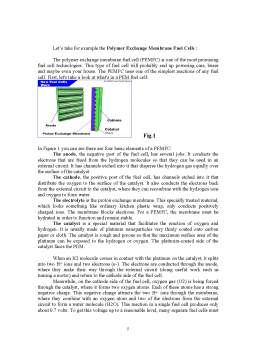Cuprins
- Purposes:
- - I. History of fuel cells
- - II. What are and how fuel cells work
- - III. Types of fuel cells
- - IV. Applications
- - V. Benefits
- - VI. Auto Companies On Fuel Cells
- - VII. A special fuel cell
- - VIII. Bibliography
Extras din proiect
I. HISTORY
Dead frog have leaded to the invention of cells and electrical batteries. In 1786, the italian scientist Luigi Galvani has discovered that dissected frogs were shrinking when they were touched by his scalpel. After that he discovered , by mistake, that the legs could had been done to move by touching them with metal. Galvani didn’t know what the phenomenon’s nature and it’s source were.
The answer was given in 1790 by the scientist Alessandro Volta. Frog’s legs were shrinking because the liquids inside them were reacting with two different metals: brassy and iron. This combination formed a fuel cell and the current produced by this was shrinking the leg’s muscles.
Volta made a fuel cell by placing a wet paper between two cupper and disks. This cell was very weak, but soon Volta realized practically cells and batteries. One of the batteries consisted by columns of electrical cells made from zinc and silver plates with paper in pickle. This kind of cellwas called voltaic cell.
The principle of the fuel cell was discovered by German scientist Christian Friedrich Schönbein in 1838 and published in the January 1839 edition of the "Philosophical Magazine". Based on this work, the first fuel cell was developed by Welsh scientist Sir William Robert Grove in 1843. The fuel cell he made used similar materials to today's phosphoric-acid fuel cell. It wasn't until 1959 that British engineer Francis Thomas Bacon successfully developed a 5 kW stationary fuel cell.
In 1959, a team led by Harry Ihrig built a 15 kW fuel cell tractor for Allis-Chalmers which was demonstrated across the US at state fairs. This system used potassium hydroxide as the electrolyte and compressed hydrogen and oxygen as the reactants. Later in 1959, Bacon and his colleagues demonstrated a practical five-kilowatt unit capable of powering a welding machine. In the 1960s, Pratt and Whitney licensed Bacon's U.S. patents for use in the U.S. space program to supply electricity and drinking water (hydrogen and oxygen being readily available from the spacecraft tanks).
United Technologies Corporation (UTC) Power subsidiary was the first company to manufacture and commercialize a large, stationary fuel cell system for use as a co-generation power plant in hospitals, universities and large office buildings. UTC Power continues to market this fuel cell as the PureCell 200, a 200 kW system.
UTC Power continues to be the sole supplier of fuel cells to NASA for use in space vehicles, having supplied the Apollo missions and currently the Space Shuttle program, and is developing fuel cells for automobiles, buses, and cell phone towers; the company has demonstrated the first fuel cell capable of starting under freezing conditions with its proton exchange membrane automotive fuel cell.
In 2003, President Bush announced a program called the Hydrogen Fuel Initiative (HFI) during his State of the Union Address. This initiative, supported by legislation in the Energy Policy Act of 2005 (EPACT 2005) and the Advanced Energy Initiative of 2006, aims to develop hydrogen, fuel cell and infrastructure technologies to make fuel-cell vehicles practical and cost-effective by 2020. The United States has dedicated more than one billion dollars to fuel cell research and development so far.
II. WHAT ARE AND HOW FUEL CELLS WORK ?
So what exactly is a fuel cell, anyway? Why are governments, private businesses and academic institutions collaborating to develop and produce them? Fuel cells generate electrical power quietly and efficiently, without pollution. Unlike power sources that use fossil fuels, the by-products from an operating fuel cell are heat and water. But how does it do this?
In principle, a fuel cell operates like a battery. Unlike a battery, a fuel cell does not run down or require recharging. It will produce energy in the form of electricity and heat as long as fuel is supplied. A fuel cell consists of two electrodes sandwiched around an electrolyte. Oxygen passes over one electrode and hydrogen over the other, generating electricity, water and heat.
Preview document
Conținut arhivă zip
- Eviroment Project.doc




































